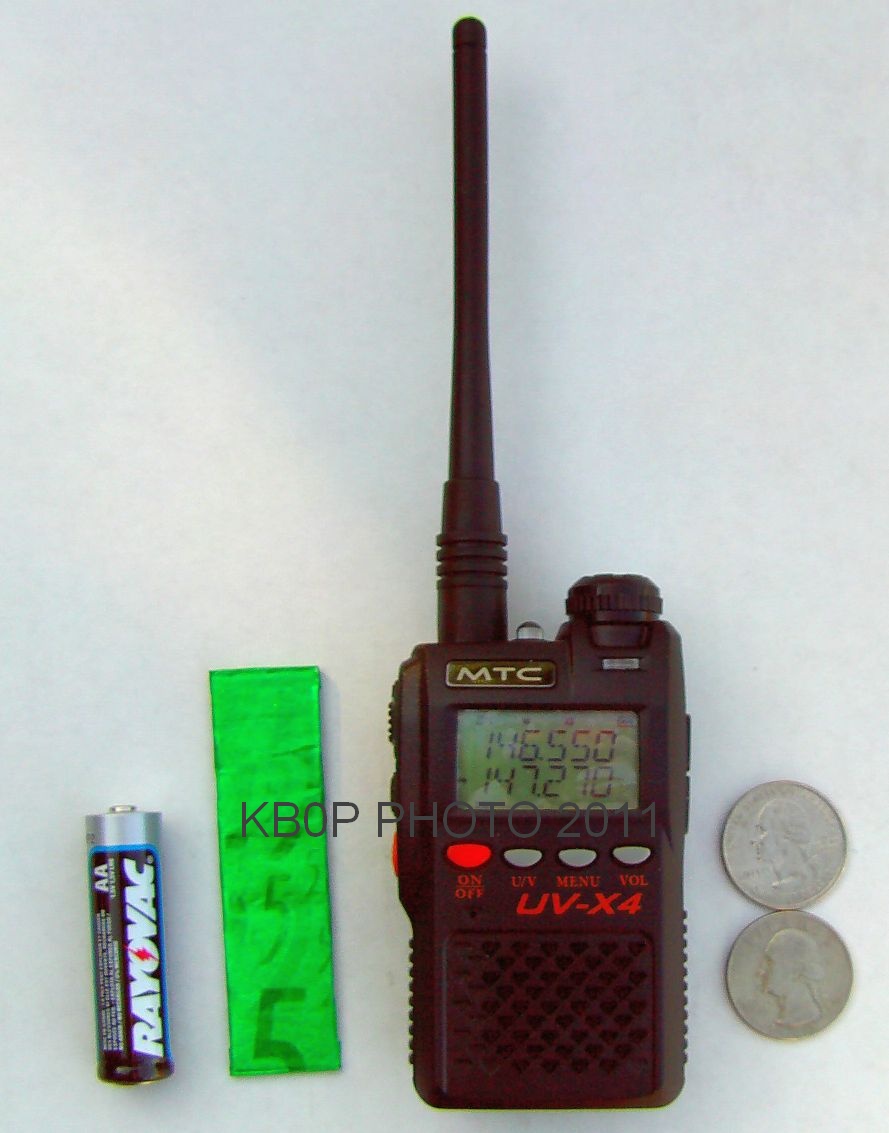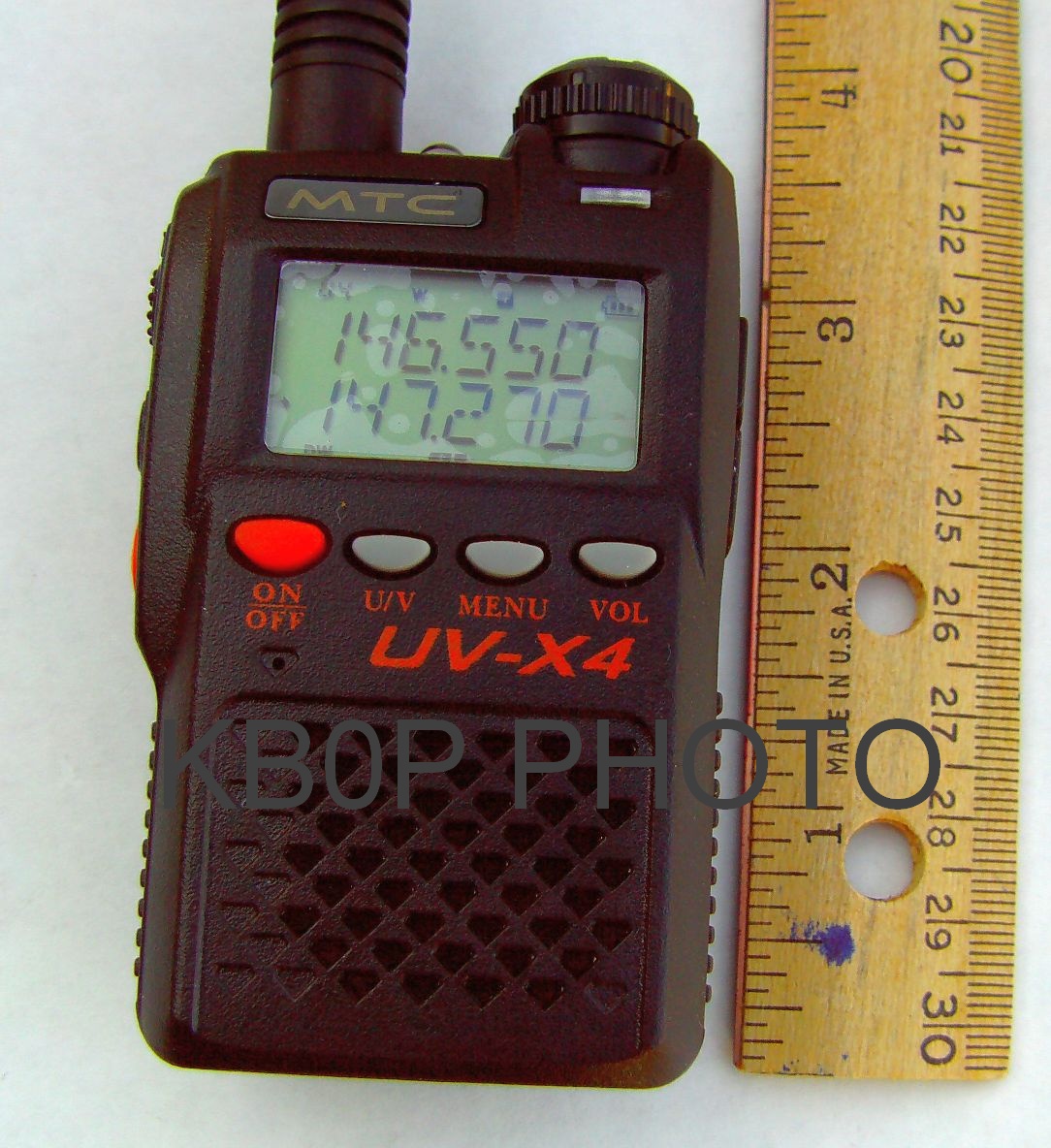

On Friday, October 22, 2011, I received in the mail a box, which contained three (3) brand new dual-band handheld radios. I ordered the radios on Monday and waited all week in anticipation-- reminiscent of years gone by-- it was like how I felt at Christmas-time as a child; time seemed to drag on slowly as the greatly awaited day drew closer and closer. The UV-X4 radios finally arrived! I cut open the box, raked through the Styrofoam peanuts and pulled out three radios and four small boxes of accessories. It was time to assemble the components and get on the air.
I first heard of the UV-X4 radios through an email advertisement received from a User Group; our IRLP Linked Repeater User Group. The UV-X4 handheld radio is manufactured by Baofeng and is being advertised as a replacement for the earlier model, UV-3R. This handheld radio is very small (weighing about 4 Oz and only 8 inches tall to the tip of the antenna), inexpensive (I paid $65 each with FREE shipping), and flexible in operation (covering both HAM and business frequency ranges). I don�t know a whole lot about the Baofeng product line, but I will do the best I can in describing my experience with the Baofeng UV-X4 handheld radio.
The UV-X4 reminds me of the Yeasu VX-2R that I once owned. I was told that this radio is similar in appearance to the newer Yaesu VX-3R,
right down to the operation of the selector knob at the top of the radio (pulls out to operate, and then pushes inward to lock).


The Baofeng UV-X4 handheld radio measures in size of about 3-3/4 inches tall, 2 inches wide, and 1 inch thick; it is as thick as the width of a stick of chewing gum, and about as tall as the length of a piece of chewing gum. Including the 4-3/4 inch long antenna, the entire length of the unit is about 8 inches long in all. With the battery installed, the radio is feather-light and weighs about 4 ounces. From what I can tell, the radio is currently only available in black, even though one may find pictures of multi-colored units on the Internet, if you look closely, the multi-colored units appear to be of the previous model, the UV-3R.
The UV-X4 is a dual-band handheld transceiver that covers the VHF frequency range of 138-174 MHz and the UHF frequency range of 400-470 MHz,
capable of transmitting and receiving in these ranges using FM (wide or narrow bandwidth). The unit also receives in the FM broadcast
band between 87.0-108.0 MHz (wide FM). This radio is FCC type 90 approved (according to what I have read on the Internet), allowing it to be
utilized on business frequencies as well as on amateur radio frequencies.
As most handheld radios, the receiver sensitivity is hot and the receiver can easily be overloaded by strong signals in the vicinity. For instance, I have a simplex node located at my home, and whenever it is transmitting, RF overwhelms the receiver and I find it difficult to listen to other frequencies on the same band at that time. I expect this with a wide-band radio, so this is not a surprise to me. Aside from the occasional interference (from strong, nearby RF sources), I was surprised by how sensitive the receiver is and pleased with how well it pulls in weak signals, from distant stations. When a signal is received, the LED in the upper-right corner switches to green as an indication of signal, and there is an S-Meter on the display, just below the bottom frequency display, which indicates general signal strength. I did notice, however, that the S-Meter reading is somewhat lagging, but this is not a big deal.
The receiver audio is plentiful, and I generally keep my volume level turned down to the lowest setting. The volume level is menu driven and incremental, which is unfortunate, because even at the lowest setting, I wish I could lower the volume even more, but the next click downward is mute.
The display is somewhat deceiving, showing two frequencies at the same time, when in fact the radio only receives one frequency at any given time; this radio is not a full-duplex dualband radio. In other words, the UV-X4 cannot listen to a VHF and UHF simultaneously. But, there is a Dual-Watch mode (DW, option 8 in the menu), which basically allows the radio to "scan" back-and-forth between the two displayed frequencies.
The transmitter produces 2 Watts on high-power and � Watt on low-power. The power level is set through a menu option (POWER, option 9 in the menu). With the supplied dual-band antenna,
I can hit most repeaters in my area, even while walking about the yard. Due to its small size, I expected the UV-X4 to get hot while transmitting on high power,
and it does get warm. I programmed the time-out timer in the menu to limit my transmission time-length, as a reminder to myself not to get too carried away
with my ragchew. The audio sounds great and I have received good reports from those with whom I have spoken. The PTT button, on the left-side of the radio,
is easy to operate (I owned a Yaesu VX-2R once, and I didn't like the PTT on that radio, because it was necessary to squeeze the radio tightly to make it operate).
While transmitting, the LED in the upper-right corner switches to red as an indication.
I purchased the optional USB programming cable for the UV-X4. This cable is a USB-to-Serial adapter with an 1/8-inch, 4-conductor plug on the opposite end for plugging into the microphone jack (which doubles as a programming jack) on the UV-X4 handheld. As all USB-to-serial adapters, a driver must be installed on the computer to allow the cable to function properly. The driver software and the programming software is supplied on a small CD with the cable, or the software can be downloaded from the Internet for FREE(!). I am glad that I purchased the cable, because the software sure makes it easy to program the UV-X4 radio.
I discovered that the UV-X4 programming software is labeled for the UV-3R MK II, the older model (another indication to me that the UV-X4 is similar to the newer UV-3R model, which is sold as the UV-3R MK II). I accidentally downloaded the UV-3R program (the older model with the single-frequency display), and there certainly is a difference in programs. So, when you search for the programming software for the UV-X4, make sure you grab the correct program-- the program for the UV-3RMkII and the UV-X4 has two VFO's over to the left-side of the GUI (as shown in the picture).
Looking at the program, one will quickly notice that there is a column to the right for "Name", and an option just above that to select "Show Channel" as a "Frequency" or "Name".
This doesn't work! A alpha-character name cannot be entered into this column because it is grayed-out. I wish that the display could be changed to display alpha-characters as an option,
especially if the radio will be used on business frequencies. Perhaps this is an indication that the manufacturer is considering this option in the future. Apart from this, I found
the program to be basic, easy to use, and a great asset for making programming a snap-- I highly recommend the purchase of the programming cable. And--
perhaps somebody could email me the answer-- maybe this programming cable will work with the Yaesu VX-2R/3R/4R/5R/7R series radios?? I wonder.
 PRO
PRO CON
CON RETURN TO HOME PAGE
RETURN TO HOME PAGE